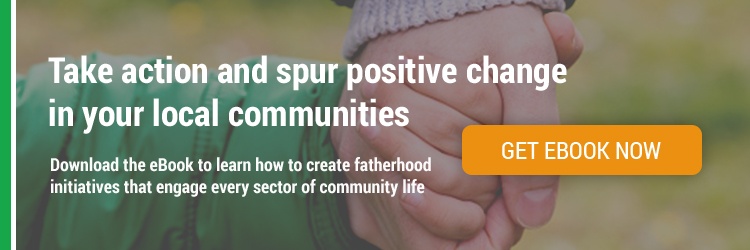
This article originally appeared in the January 2019 Child Support Report, a product of the Office of Child Support Enforcement, Administration for Children and Families, federal Department of Health and Human Services.
The Administration for Children and Families (ACF) recognizes the importance of fathers in helping their children develop and thrive. In 2014, ACF awarded funds to Temple University and the Center for Policy Research to create the Fatherhood Research and Practice Network to evaluate fatherhood programs, disseminate research findings, and promote the use of evidence-based practices.
In May 2018, the network released findings from an examination of state-level initiatives that seek to include fathers in programs and policies dealing with families. Here are some of the cross-state patterns that emerged from the research brief, State Approaches to Including Fathers in Programs and Policies Dealing with Children and Families.
- State-level fatherhood inclusion programs are rare. Only four states have broad, legislatively authorized initiatives known as fatherhood commissions. State fatherhood initiatives that operate in conjunction with child support agencies occur in fewer than a dozen states.
- Leadership by child support and other state partners is key. The executive of the state’s human services department or its child support director are key to the initiation and success of state-level father inclusion initiatives. Other key leadership partners are labor departments, which can contribute a network of workforce programs and services, and child welfare agencies that have the ability to fund prevention efforts under the new Family First Prevention Services Act.
- Sustainable state funding is critical but rare. Although 20 states nominally transfer funds such as Temporary Assistance for Needy Families (TANF) to allowable fatherhood and two-parent household programs, the average transfer is only 0.5% of TANF funds nationwide. And many of these states use the money for other two-parent household needs such as after-school care rather than fatherhood. Only four states use child support incentive funds to support employment services.
- Improving noncustodial parents’ capacity to make economic contributions is a paramount goal. With few exceptions, state initiatives and the programs they fund target parents who are not meeting their child support obligations because of unemployment or underemployment. The programs adopt a work first orientation and focus on assessing employment needs, providing employment services, and monitoring program compliance and child support payments.
- Interventions that address father engagement, effective parenting, and co-parenting are less common. State funded programs with father engagement components tend to have human services or child support agency leaders who are philosophically committed to healthy family relationships as well as employment. They also have long-standing partnerships with holistic fatherhood programs or are convinced that holistic interventions that include parenting components boost the success of workforce interventions.
- Parents access fatherhood and workforce program services in two ways. Some become involved on their own. Other parents receive referrals from child support caseworkers, probation officers, child welfare agency staff, or judicial orders as alternatives to incarceration or other sanctions for nonpayment.
- Assessments of program benefits and returns on investment are very promising. Studies of the benefits of noncustodial employment programs and fatherhood programs that have strong employment components find that child support payments and employment increase following program participation.
- Engagement in state policy is limited. With a few exceptions, fatherhood initiatives are focused on the delivery of services, have limited engagement in broader conversations about policies for children and families, and have had few opportunities to drive system-level change.
- The biggest source of fatherhood funding is program specific and time limited. Most fatherhood programs receive funding through the five-year competitive Healthy Marriage and Responsible Fatherhood grant program that involved grants to 39 organizations in 19 states for a total of $55 million per year in 2015.
Based on its review of state approaches, the network came up with six ways to improve father engagement.
- Pursue the use of state TANF funds for fatherhood services and other father inclusion initiatives, and support holistic approaches that address both the employment and parenting needs of fathers.
- Collaborate with fatherhood programs and implement enhanced child support policies such as driver’s license reinstatement and state debt compromise to support positive father engagement.
- Engage in newer initiatives dealing with two-generation and whole family programs and encourage the inclusion of nonresident fathers.
- Request that Congress change its rules to permit states to use regular child support program funds for activities dealing with fatherhood, parenting time, and employment.
- Explore the feasibility of restructuring the existing Health Marriage and Responsible Fatherhood grant program along the lines of the state Access and Visitation (AV) Mandatory Grants program. The AV program provides continuous, annual awards to states based on a formula that considers the number of children in single-parent families relative to two-parent families. It also allows each state to develop an infrastructure and programmatic strategy to deal with parenting time, and it awards grants to programs for service delivery.
- Join with other state programs and agencies, fatherhood practitioners, and other partners to create and strengthen multi-agency commissions, councils or advisory boards that convene regularly to make policies, practices, and programs more inclusive of fathers.
For more information on father inclusion, read State Approaches to Including Fathers in Programs and Policies Dealing with Children and Families. Learn more about the organization on the Federal Research and Practice Network website or become a subscriber to its electronic newsletter.
 Author:
Author:
Jessica Pearson, Ph.D., Director, Center for Policy Research and Co-Director, Fatherhood Research and Practice Network.


 Author:
Author: